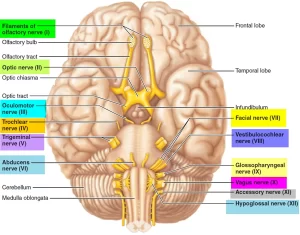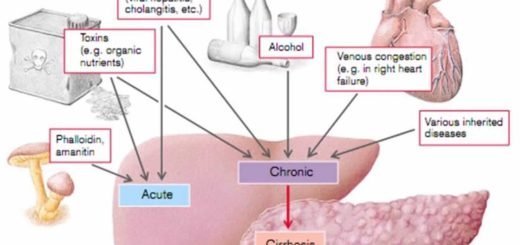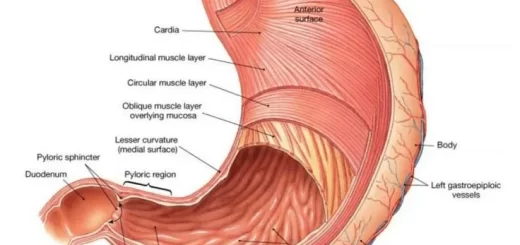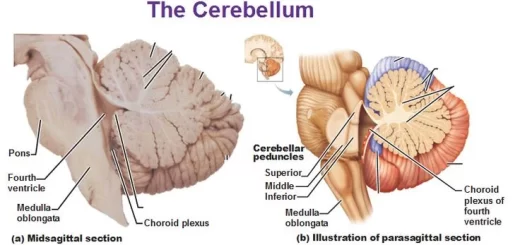Cranial nerves types, Facial, Vestibulocochlear, Glossopharyngeal, Vagus, Accessory and Hypoglossal
The cranial nerves connect the muscles and sense organs of the head and thoracic region directly to the brain, they are made up of motor neurons, sensory neurons, or both, They arise from the cerebrum or brainstem and leave the central nervous system through cranial foramina rather than through the spine, They are named and numbered (according to their location, from the front of the brain to the back), They are named for their function or structure.
7. Facial nerve
The facial nerve has a motor root and a sensory component, The facial nerve emerges on the anterior surface of the brainstem between the pons and the medulla oblongata, The roots pass laterally in the posterior cranial fossa with the vestibulocochlear nerve and enter the internal acoustic meatus in the petrous part of the temporal bone, At the bottom of the meatus, the facial nerve enters the facial canal that runs laterally through the inner ear.
On reaching the medial wall of the middle ear (tympanic cavity) the nerve expands to form the sensory geniculate ganglion, The facial nerve then bends sharply backward, At the posterior wall of the middle ear, bends down on the medial side of the aditus of the mastoid antrum, The facial nerve descends to emerge from the temporal bone through the stylomastoid foramen.
The facial nerve now passes forward through the parotid gland, Here, it gives off the terminal branches that emerge from the anterior border of the gland and pass to the muscles of the face and the scalp.
Branches of the facial nerve
- Greater petrosal nerve arises from the nerve at the geniculate ganglion, it contains the preganglionic parasympathetic fibers that synapse in the pterygopalatine ganglion, The postganglionic fibers are secretomotor to the lacrimal gland and the glands of the nose and the palate, The greater petrosal nerve also contains taste fibers from the palate.
- Nerve to stapedius supplies the stapedius muscle in the middle ear.
- Chorda tympani arises from the facial nerve in the facial canal in the posterior wall of the middle ear, It runs forward over the medial surface of the upper part of the tympanic membrane and leaves the middle ear to enter the infratemporal fossa and join the lingual nerve, The chorda tympani contains preganglionic parasympathetic secretomotor fibers to the submandibular and the sublingual salivary glands, It also contains taste fibers from the anterior two-thirds of the tongue and floor of the mouth.
- Nerve to the posterior belly of the digastric and stylohyoid muscles.
- Posterior auricular nerve to the occipitalis and auricularis posterior muscle.
- Five terminal branches to the muscles of facial expression, These are the temporal, the zygomatic, the buccal, the mandibular, and the cervical branches, The facial nerve thus controls facial expression, salivation, and lacrimation and is a pathway for taste sensation from the anterior part of the tongue and floor of the mouth and from the palate.
8. Vestibulocochlear nerve
The vestibulocochlear nerve is a sensory nerve that consists of two sets of fibers: vestibular and cochlear, They leave the anterior surface of the brainstem between the pons and the medulla oblongata, They cross the posterior cranial fossa and enter the internal acoustic meatus with the facial nerve.
- Vestibular fibers: these are the central processes of the nerve cells of the vestibular ganglion situated in the internal acoustic meatus, The vestibular fibers originate from the vestibule and the semicircular canals; therefore, they are concerned with the sense of position and with the movement of the head.
- Cochlear fibers: these are the central processes of the nerve cells of the spiral ganglion of the cochlea, The cochlear fibers originate in the spiral organ of the Corti and are therefore concerned with hearing.
9. Glossopharyngeal nerve
The glossopharyngeal nerve is a motor and sensory nerve, It emerges from the anterior surface of the medulla oblongata between the olive and the inferior cerebellar peduncle, It passes laterally in the posterior cranial fossa and leaves the skull by passing through the jugular foramen, The superior and inferior sensory ganglia are located on the nerve as it passes through the foramen.
The glossopharyngeal nerve then descends through the upper part of the neck to the back of the tongue, It passes superficially to the internal carotid artery and deep to the external carotid artery, It runs with the stylopharyngeus muscle, It passes between the superior and middle constrictors of the pharynx, It ends in the posterior third of the tongue.
Branches of the glossopharyngeal nerve
- The tympanic branch passes to the tympanic plexus in the middle ear, Preganglionic parasympathetic fibers for the parotid salivary gland now leave the plexus as the lesser petrosal nerve, and they synapse in the otic ganglion.
- The carotid branch contains sensory fibers from the carotid sinus and the carotid body.
- Nerve to the stylopharyngeus muscle.
- Pharyngeal branches run to the pharyngeal plexus.
- A lingual branch passes to the mucous membrane of the posterior third of the tongue.
- The tonsillar branch supplies the palatine tonsil and the inferior surface of the soft palate, The glossopharyngeal nerve thus assists swallowing and promotes salivation, It also conducts sensation from the pharynx and the back of the tongue and carries impulses which influence the arterial blood pressure and respiration, from the carotid sinus and carotid body.
10. Vagus nerve
The vagus nerve consists of the motor and sensory fibers, It emerges from the anterior surface of the medulla oblongata between the olive and the inferior cerebellar peduncle, The nerve passes laterally through the posterior cranial fossa and leaves the skull through the jugular foramen.
The vagus nerve has both superior and inferior sensory ganglia, At the inferior ganglion, the cranial root of the accessory nerve joins the vagus nerve and it is distributed mainly in its pharyngeal and recurrent laryngeal branches, The vagus nerve descends in the neck within the carotid sheath between the internal jugular vein and the internal carotid artery.
At the level of the upper border of the thyroid cartilage, it lies between the internal jugular vein and the common carotid artery in the carotid sheath, It passes through the mediastinum of the thorax, passing behind the root of the lung, and enters the abdomen through the esophageal opening in the diaphragm as anterior and posterior gastric nerves.
Branches of the vagus nerve in the neck
- Meningeal and auricular branches.
- The pharyngeal branch contains nerve fibers from the cranial part of the accessory nerve, This branch joins the pharyngeal plexus and supplies all the muscles of the pharynx (except the stylopharyngeus) and of the soft palate (except the tensor vell palatini).
- The superior laryngeal nerve divides into the internal and external laryngeal nerves, The internal laryngeal nerve is sensory to the mucous membrane of the piriform fossa and the larynx down as far as the vocal cords, The external laryngeal nerve is motor and is located close to the superior thyroid artery, it supplies the cricothyroid muscle.
- The recurrent laryngeal nerve, nerve is closely related to the inferior thyroid artery, and it supplies all the muscles of the larynx, except the cricothyroid muscle, the mucous membrane of the larynx below the vocal cords, and the mucous membrane of the upper part of the trachea, Only the right recurrent laryngeal nerve arises in the neck, the nerve hooks around the first part of the subclavian artery and then ascends in the groove between the trachea and the esophagus, The left recurrent laryngeal nerve arises in the thorax, it hooks around the arch of the aorta and then ascends into the neck between the trachea and the esophagus.
- Cardiac branches (two or three) arise in the neck, descend into the thorax, and end in the cardiac plexus.
- Branch to the carotid body.
- The vagus nerve thus innervates the heart and great vessels within the thorax; the larynx, trachea, bronchi, and lungs, and much of the alimentary tract from the pharynx to the splenic flexure of the colon, It also supplies glands associated with the alimentary tract, such as the liver and pancreas.
- The vagus nerve has the most extensive distribution of all the cranial nerves and supplies the aforementioned structures with afferent and efferent fibers.
11. Accessory nerve
It is a motor nerve. It consists of cranial & spinal roots:
- Cranial root emerges from the anterior surface of the medulla oblongata between the olive and the inferior cerebellar peduncle, The nerve runs laterally in the posterior cranial fossa and joins the spinal root.
- Spinal root arises from the upper five or six cervical segments of the spinal cord, The nerve ascends alongside the spinal cord and enters the skull through the foramen magnum, It then turns laterally to join the cranial root.
The two roots unite and leave the skull through the jugular foramen, The roots then separate:
- The cranial root joins the inferior ganglion of vagus nerves and is distributed in its branches to the of the soft palate and pharynx (via the pharyngeal plexus) and to the muscles of the larynx.
- The spinal root runs downward and laterally and enters the deep surface of the sternomastoid muscle, which it supplies, and then crosses the posterior triangle of the neck to supply the trapezius muscle.
The accessory nerve thus brings about movements of the soft palate, pharynx, and larynx and controls the movements of the sternomastoid and trapezius muscles.
12. Hypoglossal nerve
It is a motor nerve, It emerges on the anterior surface of the medulla oblongata between the pyramid and the olive, crosses the posterior cranial fossa, and leaves the skull through the hypoglossal canal, The nerve then passes downward and forward in the neck and crosses the internal and external carotid arteries to reach the tongue, In the upper part of its course, it is joined by C1 fibers from the cervical plexus.
Branches of the hypoglossal nerve
- Muscular branches (pure hypoglossal fibers): to all the muscles of the tongue except palatoglossus.
- Meningeal branch (C1 fibers).
- Descendens hypoglossi (C1 fibers) passes downward and joins the descending cervical nerve (C2 and 3) to form the ansa cervicalis. Branches from this loop supply the omohyoid, the sternohyoid, and the sternothyroid muscles.
- Nerve to the thyrohyoid muscle (C1).
- Nerve to the geniohyoid muscle (C1).
The hypoglossal nerve thus innervates the muscles of the tongue (except the palatoglossus) and therefore controls the shape and movements of the tongue.
Ansa cervicalis
It is a nerve loop which lies close to the lateral side of the carotid sheath/It is formed of 2 limbs or roots:
- Superior limb (root): called descendens hypoglossi, This is a branch of the hypoglossal nerve but it is formed of fibers from C1 nerve.
- Inferior limb (root): called descendens cervicalis, This limb is formed by two roots from the ventral rami of the second and third cervical nerves.
The 2 limbs unite to form a nerve loop, the ansa cervicalis, lateral to the carotid artery and carotid sheath opposite the lower part of the larynx and undercover of the sternomastoid
The ansa gives the following branches
- Nerve to sternohyoid.
- Nerve to sternothyroid.
- Nerve to the inferior belly of the omohyoid.
- Nerve to the superior belly of the omohyoid: this nerve is a branch of the superior limb (descendens hypoglossi) rather than the ansa cervicalis itself.
You can subscribe to Science Online on YouTube from this link: Science Online
You can download the Science Online application on Google Play from this link: Science Online Apps on Google Play
Cranial nerves anatomy, function, Olfactory, Optic, Oculomotor, Trochlear, Trigeminal and Abducent
Triangles of the neck contents, Structure of Anterior and Posterior triangle of the neck
Facial muscles function, anatomy, arteries, veins, names and expressions
Skull function, anatomy, structure, views & Criteria of neonatal skull
Cranial cavity anatomy, function, structure, Dural folds, Cavernous sinus and Nerve supply of scalp




